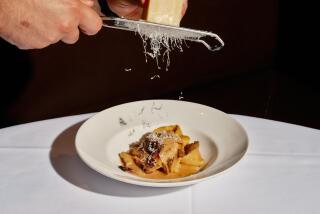The Power of the Pressure
The first pressure cooker was built in 1679 by Denis Papin, a French scientist working in England. It basically consisted of two brass tubes, each closed at one end and designed so that one fit snugly into the other. You’d put some water in the lower tube and insert a smaller tube (made of glass or pewter) filled with whatever you wanted to cook; then you’d slide the top tube over it and latch it down.
And then you’d lower the whole thing into a furnace. To prevent explosion, it had a pressure regulator like the modern pressure cooker’s jiggle top, but instead of being a weight sitting on a hissing relief valve, it was a rod with an adjustable weight at one end.
It worked on the same principle as the pressure cooker--the higher the pressure, the higher the temperature at which water will boil, so you can get moist heat at supernatural temperatures. But while a home pressure cooker can reach 266 degrees, Papin’s device could go above 550 degrees, hotter than you can get in a home oven today.
Papin called his invention a “Digester, or Engine for Softening Bones,” and by all accounts it could turn bones as soft as cheese. He figured this would be a boon for the Royal Navy. For some reason, the Navy didn’t buy the idea.
But more practically designed “digesters” or autoclaves (a word which means “self-locking,” because the internal steam pressure is what seals the device shut) were being used for exactly that purpose--processing slaughterhouse wastes--by the 1880s. Around the same time, cast-iron stove-top autoclaves were being used in some French kitchens.
The pressure cooker finally burst (pardon the expression) onto the American scene in 1939, when the National Pressure Cooker Co., now called National Presto, introduced a miniature version of the cast aluminum retorts it had long manufactured for commercial canning operations. And presto--by the ‘50s, nearly every home had a Digester.
More to Read
Eat your way across L.A.
Get our weekly Tasting Notes newsletter for reviews, news and more.
You may occasionally receive promotional content from the Los Angeles Times.










